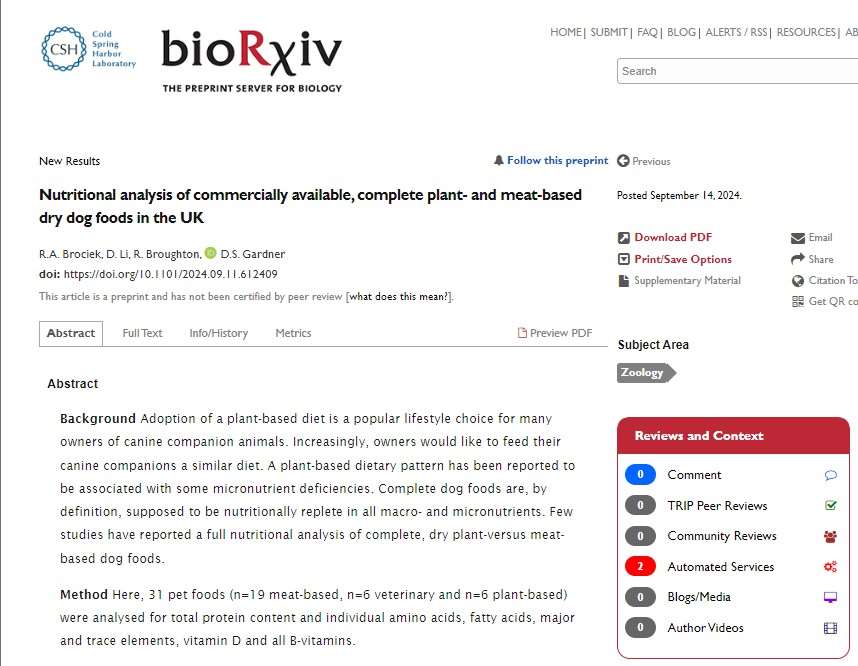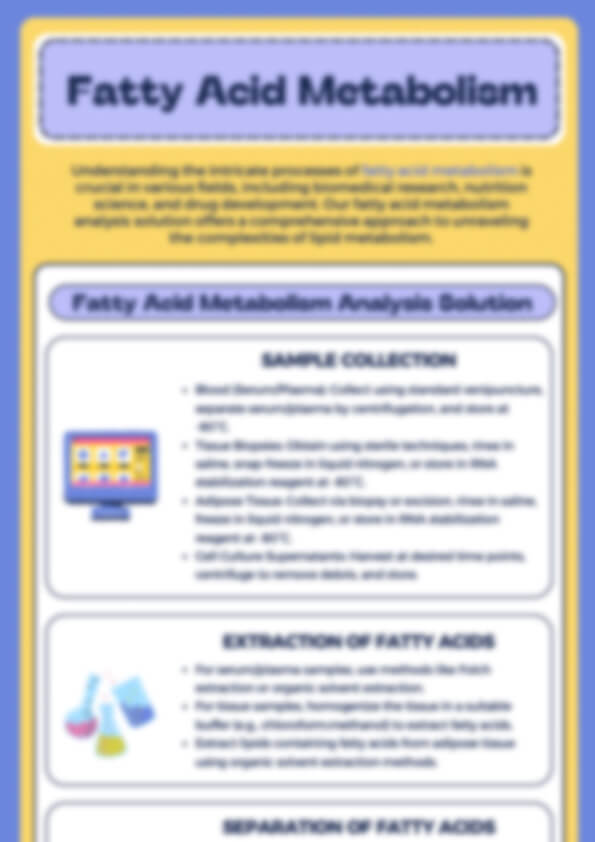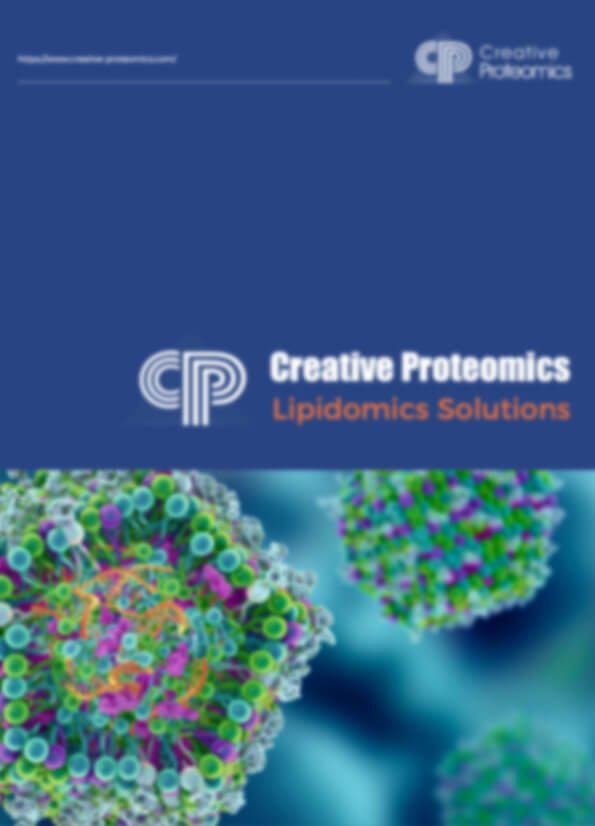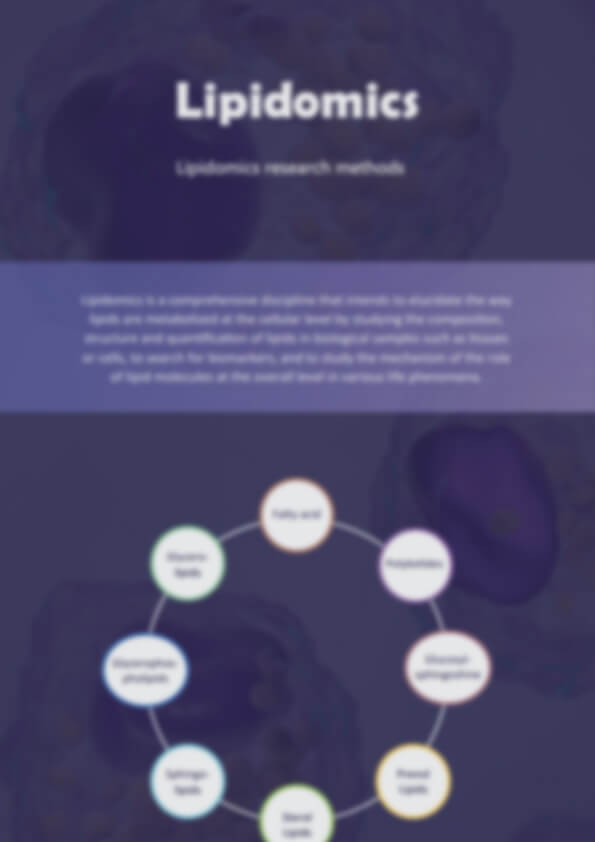Advanced LC-MS/MS Quantification of Fat-Soluble Vitamins
Creative Proteomics specializes in the precise quantification of fat-soluble vitamins—A, D, E, and K—in biological samples, particularly serum and plasma. Utilizing liquid chromatography-tandem mass spectrometry (LC-MS/MS), our approach combines the separation power of chromatography with the high specificity and sensitivity of mass spectrometry.
Simultaneous Multi-Vitamin Detection: A single injection enables the quantification of multiple fat-soluble vitamins, including vitamin A, vitamin E, vitamin K1, and vitamin D metabolites (25-hydroxyvitamin D, D2, and D3).
High Sensitivity & Specificity: The method delivers precise, low-detection-limit measurements for accurate nutritional and clinical research.
Optimized for Biological Samples: Designed specifically for serum and plasma analysis, ensuring reproducible and reliable results.
Submit Your Request Now
×- Introduction
- Why LC-MS/MS
- Methods
- Technical Advantage
- Metabolites list
- Platform
- Sample Requirement
- Report
- Case Study
- Publications
What Are Fat-Soluble Vitamins?
Fat-soluble vitamins (FSVs) are a crucial group of micronutrients that include vitamins A, D, E, and K. Unlike water-soluble vitamins, they dissolve in fats and oils, allowing them to be stored in the liver, adipose tissue, and muscles for long-term use. This storage capacity helps maintain stable vitamin levels, but excessive intake can lead to toxicity.
A balanced diet typically provides sufficient FSVs, reducing the risk of deficiencies. However, certain health conditions, dietary restrictions, or excessive supplementation can result in either deficiency or toxicity, making regular monitoring essential.

Key Functions and Benefits of Fat-Soluble Vitamins
| Vitamin | Functions | Deficiency Symptoms |
|---|---|---|
| Vitamin A | Supports vision, immune function, organ health, and acts as an antioxidant. | Night blindness, increased infection risk, dry skin, slower bone growth. |
| Vitamin D | Enhances calcium absorption, supports bone and immune health. | Soft, brittle bones, muscle weakness, increased risk of autoimmune diseases. |
| Vitamin E | Acts as an antioxidant, supports immune function, prevents blood clot formation. | Neurological issues, muscle weakness, impaired immune response. |
| Vitamin K | Essential for blood clotting and bone metabolism. | Excessive bleeding, weakened bones, vascular calcification. |
Interactions Between Fat-Soluble Vitamins
Emerging research highlights how fat-soluble vitamins interact with each other:
| Interaction | Effect |
|---|---|
| Vitamin K deficiency & Vitamin D deficiency | Often linked in children. |
| Long-term Vitamin D3 supplementation | May lower Vitamin E levels. |
| Low Vitamin A intake (colorectal cancer patients) | Correlates with reduced blood Vitamin D levels. |
| Vitamins E & A together | Improve Vitamin A absorption and utilization. |
Additionally, vitamin D2 and D3 require differentiation in clinical testing, as D3 is more potent and has a longer half-life. Certain populations may have higher D2 levels, making separate measurements necessary for accurate health assessments.
Why Is It Important to Measure Fat-Soluble Vitamins?
Both deficiency and excessive intake of fat-soluble vitamins can have significant health consequences. Monitoring their levels in blood and biological fluids provides valuable insights into potential nutritional imbalances and disease risks.
| Vitamin | Primary Roles |
|---|---|
| Vitamin A | Vision, cell function, immune regulation. |
| Vitamin D | Calcium absorption, bone growth, immune response. |
| Vitamin E | Skin health, neurological function, antioxidant protection. |
| Vitamin K | Blood coagulation, bone strength. |
Excessive intake of FSVs can lead to toxicity, causing symptoms like nausea, dizziness, organ damage, and metabolic disruptions. Therefore, precise measurement is essential in both clinical and nutritional settings.
Challenges in Measuring Fat-Soluble Vitamins
Traditional vitamin analysis methods include immunoassays, spectrophotometry, and liquid chromatography. However, these techniques often face challenges such as:
Limited Sensitivity: Difficulty detecting low-concentration vitamins like 25-hydroxyvitamin D2 and vitamin K1.
Complex Matrices: Intracellular vitamin levels vary widely, making accurate measurement difficult.
Lack of Simultaneous Analysis: Many methods assess only one vitamin at a time, reducing efficiency.
Key Advantages of LC-MS/MS for Vitamin Analysis
Liquid chromatography-tandem mass spectrometry (LC-MS/MS) has become the gold standard for detecting small molecules, including vitamins, due to its unmatched structural specificity. Unlike immunoassays, LC-MS/MS does not require antibodies, enabling rapid adaptation to new assays and the simultaneous measurement of multiple analytes with high accuracy, sensitivity, and specificity.
Comparing Vitamin Detection Methods
| Method | Types of Detection | Reproducibility | Sensitivity | Stability | Accuracy | Sample Size Required |
|---|---|---|---|---|---|---|
| Microbiological | Few | Poor | Low | Poor | Low | Large |
| Immunoassay | Many | Good | Low | Good | Moderate (cross-reactivity issues) | Large |
| Electrochemical | Few | Poor | High | Low (environmental interference) | High | Large |
| LC-MS/MS | Most | Good | Very High | Good | Highest | Minimal |
For precise, high-throughput vitamin quantitation with minimal sample input, LC-MS/MS is the superior choice, ensuring robust and reproducible results for nutritional and clinical research.
Why Choose Our LC-MS/MS Platform for Vitamin Detection?
Unparalleled Sensitivity & Specificity: Detects and quantifies vitamins at trace levels with minimal interference.
Multiplex Capability: Measures multiple vitamins in a single assay, reducing sample volume requirements.
Precise Differentiation: Accurately distinguishes between structurally similar compounds like vitamin D2 and D3.
Superior Stability & Reproducibility: More consistent and reliable than microbiological and immunoassay methods.
Metabolites list
| Fat-soluble Vitamins Quantified in Our Service | ||
|---|---|---|
| Vitamin A (Retinol) | Vitamin D2 | Vitamin D3 (Cholecalciferol) |
| Vitamin E (Tocopherol) | Vitamin E Acetate (Tocopherol acetate) | Vitamin K1 (Phylloquinone) |
| Vitamin K2 (Menaquinone) | ||
| Other Vitamins | ||
| Vitamin-like Compounds | Water Soluble Vitamins | |
Detection Platform

Agilent 1290-6470 (image source: agilent.com)

Sciex QTRAP 6500+ (image source: Sciex QTRAP 6500+)
Sample Requirements
| Sample type | Recommended sample size |
|---|---|
| Tissue | >200 μL |
| Urine | 200-500 μL |
| Serum/plasma | >100 μL |
| Cerebrospinal fluid, amniotic fluid, bile and other body fluids | >200 μL |
| Suspension cells | >1*107 |
| Walled cells | >1*107 |
| Cell supernatant | >1 mL |
Report
- A detailed technical report will be provided at the end of the whole project, including the experiment procedure, MS instrument parameters.
- Analytes are reported as uM/mL, while CV's are generally 10%.
- The name of the analytes, abbreviation, formula, molecular weight and CAS# would also be included in the report.
Demo
Case Study: Client Success Stories

Nutritional analysis of commercially available, complete plant- and meat-based dry dog foods in the UK
doi: https://doi.org/10.1101/2024.09.11.612409
- Background
- Methodology
- Key Findings
- Conclusion
As the pet food industry evolves, plant-based dog food has emerged as an alternative to traditional meat-based formulations. However, key nutritional differences exist between these two categories, particularly in vitamin and mineral content. These discrepancies may impact pet health, necessitating a comprehensive nutritional evaluation.
This study analyzed plant-based and meat-based dog foods available in the UK market, with a focus on fat-soluble vitamin D and water-soluble B vitamins. To ensure accuracy, the research team partnered with Creative Proteomics, utilizing targeted metabolite quantification via high-sensitivity LC-MS/MS to precisely measure vitamin levels and assess nutritional adequacy.
A multi-faceted approach was employed for nutritional assessment, with Creative Proteomics responsible for the precise quantification of vitamin D (fat-soluble) and B vitamins (water-soluble). The process included:
Sample Preparation:
Various plant-based and meat-based dog food brands were homogenized to ensure representative sampling.
Targeted Metabolomics Analysis (Creative Proteomics):
Technology: LC-MS/MS was utilized for targeted metabolite quantification, ensuring high sensitivity and specificity.
Analytes Measured:
Vitamin D (fat-soluble): Levels of D2 (ergocalciferol) and D3 (cholecalciferol) were assessed to determine potential nutritional gaps.
B vitamins (water-soluble): Concentrations of B1 (thiamine), B2 (riboflavin), B6 (pyridoxine), and B12 (cobalamin) were compared between plant- and meat-based formulas.
Calibration Standards: Internal standards were used to validate quantification accuracy.
Additional Nutritional Assessments:
Protein, fatty acid, and mineral composition were also analyzed for a holistic nutritional profile.
Creative Proteomics' targeted metabolomics analysis enabled precise quantification of vitamin levels, revealing significant differences between plant- and meat-based dog foods:
Vitamin D (Fat-Soluble):
Plant-based dog foods contained significantly lower vitamin D levels compared to meat-based counterparts.
Vitamin D3 (cholecalciferol), the biologically superior form, was nearly absent in plant-based formulations, potentially leading to deficiencies that could affect bone health.
While Vitamin D2 (ergocalciferol) was present in some plant-based products, its bioavailability is lower than D3, indicating a need for supplementation.
B Vitamins (Water-Soluble):
Vitamin B12 (Cobalamin): Almost undetectable in plant-based formulas, confirming the necessity of supplementation, as B12 is predominantly derived from animal sources.
Vitamin B6 (Pyridoxine) and B1 (Thiamine): Present in comparable levels across both food types, suggesting that plant-based sources can adequately provide these nutrients.
Vitamin B2 (Riboflavin) and B3 (Niacin): Higher concentrations were found in meat-based products, with slightly lower B2 levels in plant-based dog food, highlighting a potential area for fortification.
Data-Driven Nutritional Recommendations:
The study confirmed significant gaps in vitamin D3 and B12 content in plant-based dog foods, which could impact pet health over time.
Through Creative Proteomics' targeted metabolomics analysis, researchers obtained precise nutritional insights, guiding potential formulation improvements for better-balanced pet food products.
 Vitamin content (B1-B12, D) of dry feeds for dogs according to feed-type
Vitamin content (B1-B12, D) of dry feeds for dogs according to feed-type
This case study underscores Creative Proteomics' expertise in precise vitamin quantification using LC-MS/MS-based targeted metabolomics analysis. The study provided critical insights into the nutritional discrepancies between plant- and meat-based dog foods, particularly regarding vitamin D and B12 deficiencies in plant-based formulas. These findings are invaluable for pet food manufacturers aiming to optimize formulations and ensure nutritionally complete products for pet health.
Our Vitamins Analysis Review

- THE ROLE OF INTRA-TUMORAL MICROBIOME IN MODULATING MUCOSAL-ASSOCIATED INVARIANT T CELL (MAIT) FUNCTION IN LUNG CANCER (Doctoral dissertation, Johns Hopkins University). Yang, X. 2024. https://jscholarship.library.jhu.edu/items/f7b260ea-038e-4719-90e1-0da47a14711c.
- Nutritional analysis of commercially available, complete plant-and meat-based dry dog foods in the UK. Brociek, R. A., Li, D., Broughton, R., & Gardner, D. S. 2024. https://doi.org/10.1101/2024.09.11.612409.
- Fatty Acid and Antioxidant Profile of Eggs from Pasture-Raised Hens Fed a Corn- and Soy-Free Diet and Supplemented with Grass-Fed Beef Suet and Liver. Sergin, S., Jambunathan, V., et al. 2022. https://doi.org/10.3390/foods11213404.
How to place an order:

*If your organization requires signing of a confidentiality agreement, please contact us by email
With integrated set of separation, characterization, identification and quantification systems featured with excellent robustness & reproducibility, high and ultra-sensitivity, Creative Proteomics provides reliable, rapid and cost-effective fat-soluble vitamins targeted metabolomics services.















